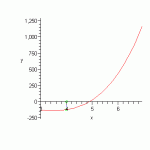We know that \(\displaystyle 2^{2}=4\) and \(\displaystyle 3^{2}=9\)
So, \(\displaystyle \sqrt{5}\) has to be between 2 and 3.
Make an initial guess of 2. It will eventually converge.
Here we have something known as the Mechanic's Rule/Babylonian Method of finding a square root by hand.
It can be derived from Newton's method, but goes back further.
One of the ways they done it before calculators.
To find \(\displaystyle \sqrt{a}\) with an intial guess of \(\displaystyle x_{n}\)
\(\displaystyle x_{n+1}=\frac{1}{2}\left(x_{n}+\frac{a}{x_{n}}\right)\)
Let's take \(\displaystyle x_{n}=2\), since we know it is going to be 2 and some change.
\(\displaystyle \frac{1}{2}\left(2+\frac{5}{2}\right)=\frac{9}{4}=2.25\)
\(\displaystyle \frac{1}{2}\left(2.25+\frac{5}{2.25}\right)=\frac{161}{72}=2.236\overline{1}\)
Keep going. This converges very fast, so not many iterations are needed.
Keep going until you get within the desired accuracy.
Do it for \(\displaystyle \sqrt{7}\) and add them.
To use Newton's Method: \(\displaystyle x_{n+1}=x_{n}-\frac{f(x_{n})}{f'(x_{n})}\)
To approximate \(\displaystyle \sqrt{5}\), apply Newton to \(\displaystyle x^{2}-5\)
To approximate \(\displaystyle \sqrt{7}\), apply Newton to \(\displaystyle x^{2}-7\)
\(\displaystyle x_{n+1}=x_{n}-\frac{(x_{n})^{2}-5}{2x_{n}}\)
Make an initial guess and keep iterating. As before, it converges fast.
Notice the similarity to the first method. It is the same thing. A little algebraic fanaggling and we have it.

